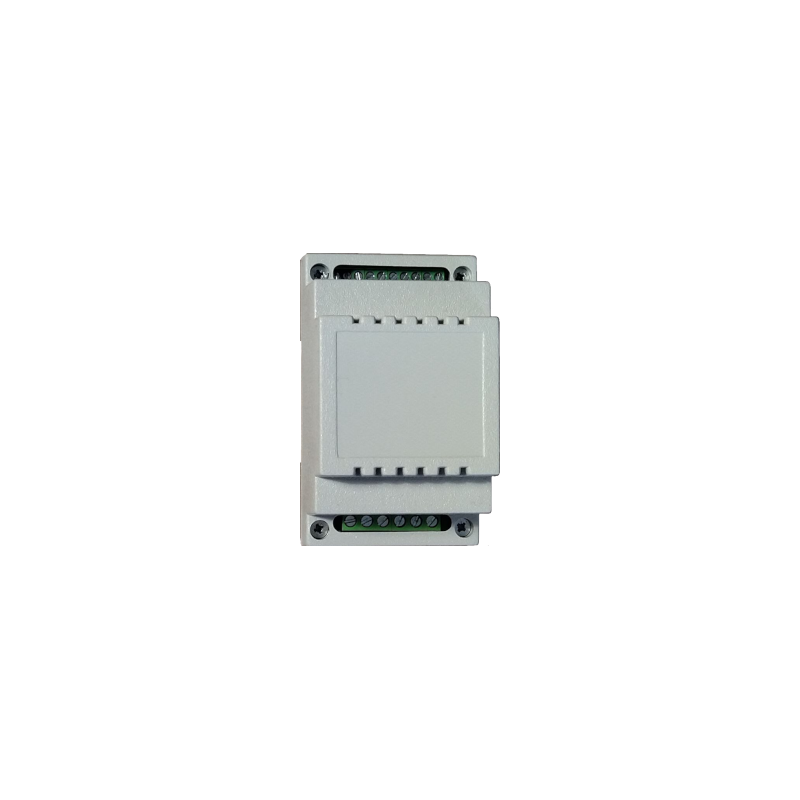

Email: store@creasol.it - Telegram: CreasolTech - Whatsapp: +393283730010
Prioritārais pasts: ātri un lēti - Express kurjer
Pirms preču atgriešanas sazinieties ar mums!

DomBus34 ir aDIN-RAIL modulis, 54 mm plats,paredzētsinterfeiss līdz 4 jaudas/enerģijas skaitītājiem, ierakstiet DDS 238-2 ZN/S (Modbus), lai izmērītujauda un enerģija (gan importēta, gan eksportēta), sprieguma frekvence un jaudas koeficients.
Tā īsteno2 releju izejas250V 5A SPST ar aizsardzību pret pārspriegumu,1 maiņstrāvas ieeja110-240 V maiņstrāva un2 zemsprieguma ieejasko var savienot ar spiedpogām un slēdžiem, dubultām spiedpogām un skaitītājiem.
 Pilns atbalsts: lielāko daļu produktu izstrādājam mēs!
Pilns atbalsts: lielāko daļu produktu izstrādājam mēs!
Email: store@creasol.it - Telegram: CreasolTech - Whatsapp: +393283730010
 Pasūtījumi tiek nosūtīti 1 darba dienas laikā
Pasūtījumi tiek nosūtīti 1 darba dienas laikā
Prioritārais pasts: ātri un lēti - Express kurjer
 24 mēnešu garantija, ērta atgriešana/atmaksa
24 mēnešu garantija, ērta atgriešana/atmaksa
Pirms preču atgriešanas sazinieties ar mums!
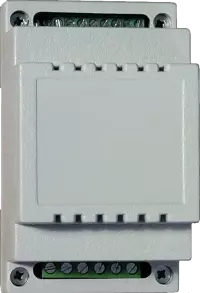 DomBus34 ir aDIN-RAIL modulis, 54 mm plats,paredzētsinterfeiss līdz 4 jaudas/enerģijas skaitītājiem, ierakstiet DDS 238-2 ZN/S (Modbus), lai izmērītujauda un enerģija (gan importēta, gan eksportēta), sprieguma frekvence un jaudas koeficients.
DomBus34 ir aDIN-RAIL modulis, 54 mm plats,paredzētsinterfeiss līdz 4 jaudas/enerģijas skaitītājiem, ierakstiet DDS 238-2 ZN/S (Modbus), lai izmērītujauda un enerģija (gan importēta, gan eksportēta), sprieguma frekvence un jaudas koeficients.
Tā īsteno2 releju izejas250V 5A SPST ar aizsardzību pret pārspriegumu,1 maiņstrāvas ieeja110-240 V maiņstrāva un2 zemsprieguma ieejasko var savienot ar spiedpogām un slēdžiem, dubultām spiedpogām un skaitītājiem.
Tas ir paredzēts, laiaktivizēt slodzes, pamatojoties uz jaudas pieejamību, piemēram, kad ražo fotoelementu vai vēja sistēmu, un uzparādīt jaukas diagrammas ar statistiku par enerģijas ražošanu/izlietojumuar salīdzinājumiem pa gadiem.
Slodzes pārslēgšanu var panākt, izmantojot DCMD komandas, bet kā tas darbojas arDomotičsmājas automatizācijasistēmu, to ir arī viegli izgatavotvizuālie un teksta skripti, lai veiktu pat sarežģītas automatizācijas.
Tāpat kā citi DomBus moduļi,visus portus var konfigurēt dažādos veidos, un arī šis modulisatbalsta DCMD, komandas, kas tiek nosūtītas uz tiem pašiem vai citiem moduļiemveikt vienkāršas darbības, kas ļauj sasniegt augstu uzticamību(DCMD komandas darbojas pat tad, ja domotic kontrolleris nedarbojas) un vienkārša programmēšana (nav nepieciešams izveidot automatizāciju domotic kontrollerī, vienkārši konfigurējiet DomBus portus, lai veiktu darbības ar notikumiem). Pēdējais, bet ne mazāk svarīgi, tāpat kā citi DomBus moduļi, tas ir optimizēts, lai iegūtu zemu enerģijas patēriņu, parasti ir mazāks par 10 mW (0,75 mA @ 13,6 V) un mazāks par 150 mW, kad visi releji ir IESLĒGTI (10 mA @ 13,6 V).
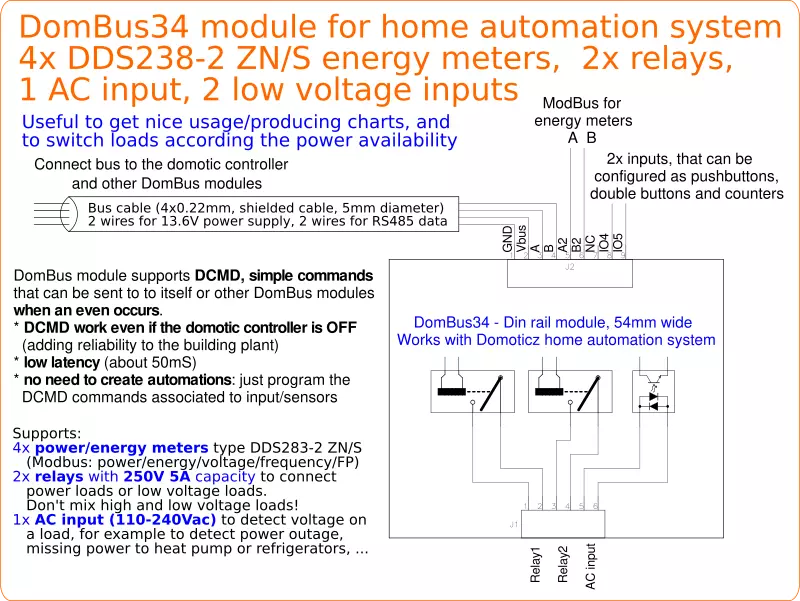
DDS238-2 ZN/S enerģijas skaitītāji ir rūpnīcā ieprogrammēti ar Modbus adresi = 1. Ikreiz, kad Modbus tiek pievienots jauns enerģijas skaitītājs, tā noklusējuma adrese ir jāmaina uz 2, 3, 4 vai 5, izvēloties ierīci.M1 Adrun ierakstot ierīcē Apraksts ADDR=2 , piemēram: tādā veidā enerģijas skaitītājs ar Modbus addr=1 tiks ieprogrammēts ar jauno izvēlēto adresi.
Ikreiz, kad tiek pievienots jauns enerģijas skaitītājs, tiks iespējots jauns ierīču komplekts, kas parāda pašreizējo importa un eksporta jaudu/enerģiju, spriegumu, jaudas koeficientu un frekvenci.
*Lūdzu, pārbaudiet lapu angļu valodā, lai iegūtu pareizās komandu vērtības!
Lai gan ir iespējams veikt jebkādu automatizāciju, izmantojot domotic kontrollera funkcijas,būtiskas automatizācijas var veikt, izmantojot DCMD komandas, kuras izpilda tieši DomBus modulis. DCMD komandas jānorāda ierīces aprakstā,strādāt pat tad, ja domotic kontrolleris ir bezsaistē un var tikt nosūtīts uz to pašu moduli vai citiem DomBus moduļiemsavienots ar to pašu autobusu.
Sintakse irDCMD(Event:ValueLow:ValueHigh)=Moduļa adrese.ModuļaPorts:Komanda:Vērtība
kur ValueLow, ValueHigh, Value ir neobligāti parametri.
<tr>IZSLĒGTSTas notiek pat tad, ja ievade (IO1, IO2 vai INAC) tiek izslēgta
DCMD(OFF)=3401.1:OFF Kad ieeja izslēdzas, tiek IZSLĒGTS arī moduļa 3401 ports 1
DCMD(OFF)=3102.1:OFF Kad ieeja izslēdzas, tiek IZSLĒGTS arī moduļa 3102 ports 1
| Pasākums | Apraksts | Piemērs |
| IESLĒGTS | Tas notiek pat tad, ja ievade (IO1, IO2 vai INAC) tiek ieslēgta |
DCMD(ON)=3401.1:ON:90s Kad ievade tiek ieslēgta, IESLĒGTS 3401. moduļa 1. portu uz 90 s. DCMD(ON)=3102.1:ON Kad ievade tiek ieslēgta, IESLĒGTS moduļa 3102 ports 1 |
| PULSS | Ievade tiek impulsa IESLĒGTA mazāk nekā 0,5 s | DCMD(impulss)=13,3: PĀRSLĒGT Kad ievade īsi tiek pulsēta, nosūtiet komandu uz moduļa 13 portu 3, lai pārslēgtu tā izvadi OFF->ON vai otrādi |
| PULSS1 | Ievade tiek impulsa IESLĒGTA apmēram 1 s |
DCMD(impulss1)=13,3:IESL |
| PULSS2 | Ievade tiek impulsa IESLĒGTA apmēram 2 sekundes |
DCMD(impulss2)=13,3:IZSL |
| PULSS4 | Ievade tiek impulsa IESLĒGTA apmēram 4 s |
DCMD(impulss4)=13,4:ON:2h |
| VĒRTĪBA | Sensora vērtība ir ≥ ValueLow un < ValueHigh Komanda tiek atkārtota ik pēc 30 s, ja salīdzinājums atbilst. |
DCMD(Vērtība:0:100)=31,8:IZSL DCMD(Vērtība:0:248)=34,2:IZSL |
Pieņemot, ka DomBus34 modulim ir adrese 3401, izvēloties Grid Import Energy ierīci un ierakstot apraksta laukā
DCMD(Vērtība:1800:65000)=3401.1:IESL
ir iespējams konfigurēt ierīci, lai tā automātiski iespējotu releju1, ja eksporta jauda ir lielāka vai vienāda ar 1800 W ( piemēram, lai aktivizētu katlu vai citu slodzi ).
Šādas komandas ierakstīšana Grid Import Energy
DCMD(Vērtība:500:65000)=3401.1:IZSL.,
DomBus34 modulis tiks konfigurēts, lai atspējotu releju1, ja importētā jauda ir lielāka par 500 W. Šo darbību iekšēji pārvalda modulis DomBus34, un domotic kontrolleris tiks informēts par Relay1 izejas stāvokli.
Līdzīgi ierakstot šādas komandas uz tīkla sprieguma ierīci
DCMD(Vērtība:252:280)=3401.2:IESL, DCMD(Vērtība:0:248)=3401.2:IZSL.
ir iespējams aktivizēt releja 2 izeju, kad spriegums paaugstinās līdz 252 V vai vairāk, releju 2 atspējot, ja spriegums nokrītas zem 248 V: tas var būt noderīgi vasarā, lai izvairītos no invertora atvienojumiem (pārsprieguma aizsardzība), iespējojot slodzi vai atvienojot fotoelektrisko virkni.
Ja izvade, kas jāiespējo/atspējo, atrodas citā DomBus modulī, vienkārši norādiet tā adresi(piemēram, 0001.8)un šī izeja tiks iespējota/atspējota, pamatojoties uz pašreizējo jaudu vai sprieguma vērtību.
The following video shows a presentation of some domotic modules designed and produced in Italy by Creasol to make a reliable, easy and power-optimized home automation system.
The next video shows our Smart EVSE module that can be used to charge the electric car by using only solar power, or adding 25/50/75/100% of available power from the electrical grid.
Our industrial and home automation modules are designed to be
Modules are available in two version:
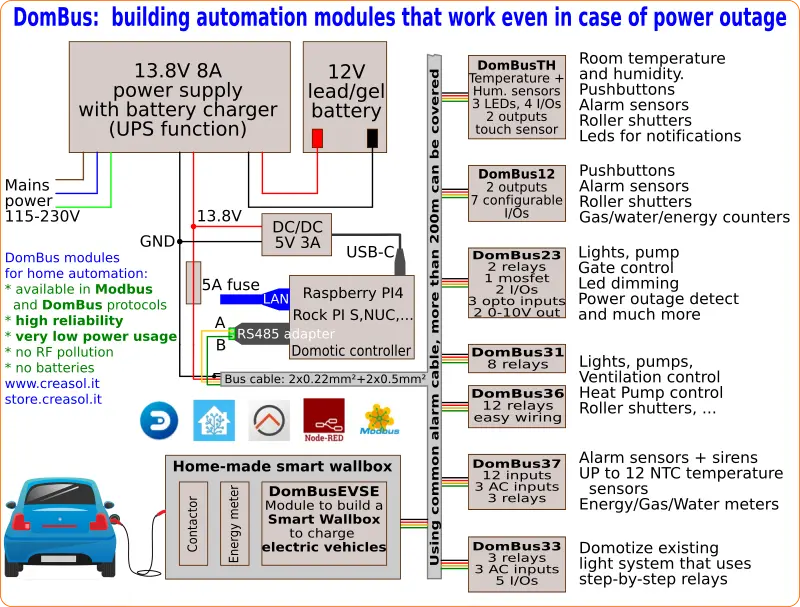
Store website - Information website
For our products we can offer FULL SUPPORT and CUSTOMIZATION: please contact us by Email or Telegram
 Complete solution to make a Smart EVSE, charging the electric vehicle using only energy from renewable source (photovoltaic, wind, ...), or adding 25-50-75-100% of available power from the grid.
Complete solution to make a Smart EVSE, charging the electric vehicle using only energy from renewable source (photovoltaic, wind, ...), or adding 25-50-75-100% of available power from the grid.
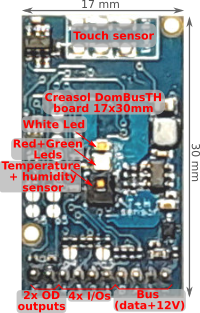 Compact board, 32x17mm, to be installed on blank cover with a 4mm hole in the middle, to exchange air for the relative humidity sensor. It can be installed in every room to monitor temperature and humidity, check alarm sensors, control blind motor UP/DOWN, send notifications (using red and green leds) and activate white led in case of power outage.
Compact board, 32x17mm, to be installed on blank cover with a 4mm hole in the middle, to exchange air for the relative humidity sensor. It can be installed in every room to monitor temperature and humidity, check alarm sensors, control blind motor UP/DOWN, send notifications (using red and green leds) and activate white led in case of power outage.
Includes:
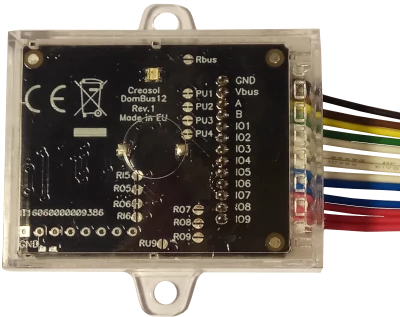 Very compact, versatile and cost-effective module with 9 ports. Each port can be configured by software as:
Very compact, versatile and cost-effective module with 9 ports. Each port can be configured by software as:
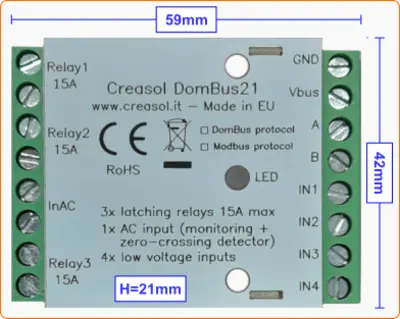 Very low power consumption module designed to enable up to 3 high power loads, up to 15A (3kW).
Very low power consumption module designed to enable up to 3 high power loads, up to 15A (3kW).
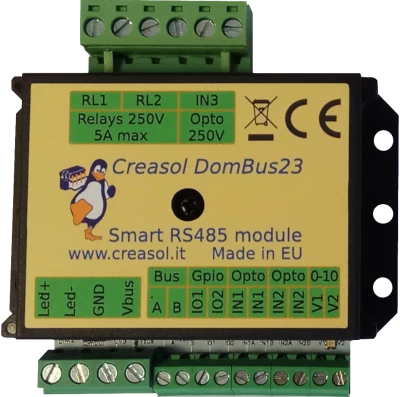 Versatile module designed to control gate or garage door.
Versatile module designed to control gate or garage door.
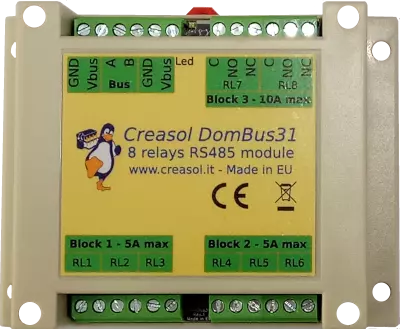 DIN rail low profile module, with 8 relays and very low power consumption:
DIN rail low profile module, with 8 relays and very low power consumption:
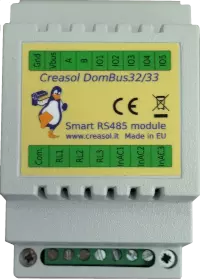 Versatile module with 230V inputs and outputs, and 5 low voltage I/Os.
Versatile module with 230V inputs and outputs, and 5 low voltage I/Os.
 Module designed to control 3 lights already existing and actually controlled by 230V pushbuttons and step-by-step relays. In this way each light can be activated by existing pushbuttons, and by the domotic controller.
Module designed to control 3 lights already existing and actually controlled by 230V pushbuttons and step-by-step relays. In this way each light can be activated by existing pushbuttons, and by the domotic controller.
Each relay can toggle the existing step-relay, switching the light On/Off. The optoisolator monitors the light status. The 5 I/Os can be connected to pushbuttons to activate or deactivate one or all lights.
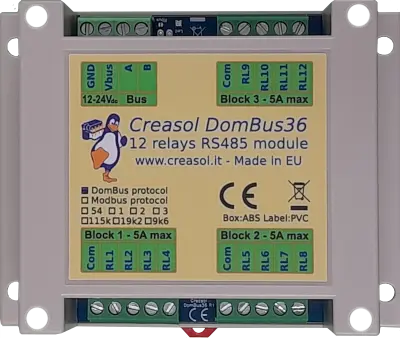 DIN rail module, low profile, with 12 relays outputs and very low power consumption.
DIN rail module, low profile, with 12 relays outputs and very low power consumption.
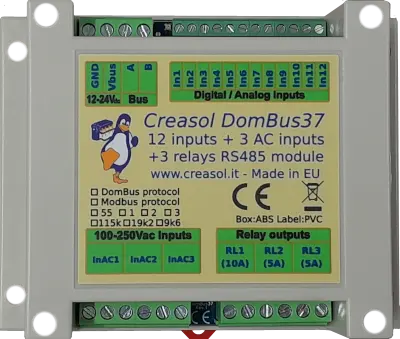 Module designed to be connected to alarm sensors (magnetc contact sensors, PIRs, tampers): it's able to monitor mains power supply (power outage / blackout) and also have 3 relays outputs.
Module designed to be connected to alarm sensors (magnetc contact sensors, PIRs, tampers): it's able to monitor mains power supply (power outage / blackout) and also have 3 relays outputs.
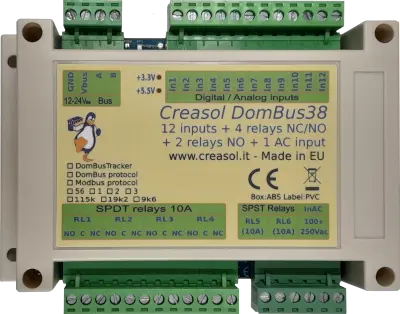 DIN rail module designed for burglar alarm system.
DIN rail module designed for burglar alarm system.
![]() DIN rail module that control azimuth + elevation/tilt motors of a sun tracker, to maximize photovoltaic energy production during the day and seasons.
DIN rail module that control azimuth + elevation/tilt motors of a sun tracker, to maximize photovoltaic energy production during the day and seasons.
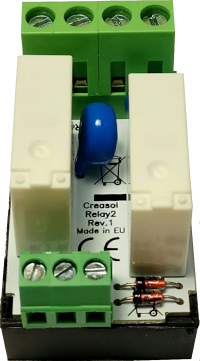 Simple module with 2 relays, to be used with DomBus modules or other electronic boards with open-collector or open-drain outputs
Simple module with 2 relays, to be used with DomBus modules or other electronic boards with open-collector or open-drain outputs
 IoT board designed for NodeMCU v3 board using ESP8266 WiFi microcontroller
IoT board designed for NodeMCU v3 board using ESP8266 WiFi microcontroller